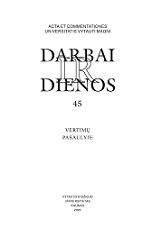Prievarta ar apaštalavimas? Misijos ir kryžiaus karai prieš baltus
Coercion or evangelization? Missions and Crusades against the Balts
Author(s): Marius ŠčavinskasSubject(s): Philosophy
Published by: Vytauto Didžiojo Universitetas
Keywords: Coercion; evangelization; Missions; Crusades; Balts;
Summary/Abstract: In historiography, the terms military/coercive missions and Crusades are evaluated as synonyms, although in their definitional senses these concepts are different and vary in degrees. The so-called military/ coercive missions are not part of the history of war, which cannot be said of the Crusades. The Crusades were carried out by the crusaders who were often called the pilgrims. However, such labeling is part of war rhetoric which attempted to elevate them to the level of Christ. The fact that from the beginning of the 12th century to the 14th century missions and conquests on the Eastern shore of the Baltic sea were contemporaneous, allowed many researchers to speak of military/coercive missions, although as it became clear, there were also certain coercive elements in the earlier missions, which till then were labeled as peaceful. (These coercive elements are mentioned by the chroniclers Thietmar of Merseburg (beginning of the 11th century), Helmold of Bosau (middle of the 12th century), Henry of Livonia (Henricus de Lettis) (beginning of the 13th century), the historiographies of St. Brunon of Querfurt (beginning of the 11th century), st. Otton of Bamberg (12th century)). With this consideration it becomes clearer that war was one of many means of coercion against pagan Balts (and also against the pagan Slavs of Palabis); thus the coercion itself does not determine the nature of military missions. Therefore a question can be raised: is it fruitful to distinguish wars from missions?
Journal: Darbai ir dienos
- Issue Year: 2005
- Issue No: 44
- Page Range: 5-25
- Page Count: 21
- Language: Lithuanian

